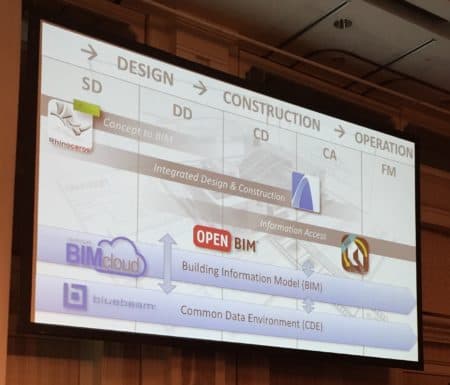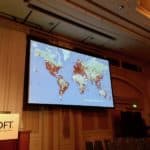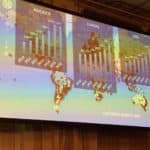Earlier this week in Kyoto, Japan, GRAPHISOFT CEO Viktor Varkonyi, delivered what was essentially the conference’s keynote address to begin two massively filled days of illuminating presentations by many of its key clients.
A Global Growth Story
Varkonyi began his talk about discussing the company’s global growth story and put up a slide that was a type of customer density map on a global scale. (see image 01-A) One could instantly see that while the company has customers all around the world their greatest concentration of customers clearly lies in Europe.
Put another way, Europe is where GRAPHISOFT has its highest market share. But the next slide showed the growth story, which was quite interesting for two points. The first is that in Asia the company had astounding growth over the past year; from 2015 through 2016 growth in Asia was at 42%, a sharp contrast to its flat growth in the Americas. (see image 01-B)
This Asia growth did not just instantly come about. The Budapest-based BIM company has been laying the foundation for growth in Asian countries for years, including key agreements in China and Singapore as well as initiatives in South Korea. (see: Architosh, “GRAPHISOFT partners with buildingSMART Korea to foster national BIM standards,” 19 Dec 2014). It seems that the fruits of this labor are starting to really accelerate and that is a key takeaway from this early part of the presentation.
As for the issue of flat-ish growth for just one year in the Americas, this looks like an outlier year when compared against the earlier five years in the Americas which saw very strong year-over-year growth as well. Overall, the growth picture is confidence-building and was no doubt an important point to lead off with to its opening presentation to over 300 key client conference participants in Kyoto.
A Final Preamble About Japan
Graphisoft’s Japan story is largely centered around its key partnerships with the country’s largest construction companies and its strategic development partnership with Japan’s largest architecture firm (really an architect-led AE firm), Nikken Sekkei. Architosh will delve into this in upcoming KCC 2017 reports but suffice to say now, presentations by these firms at the Kyoto event showed firm commitments and interesting technology impacting developments on the software development side.
This leads us to the most interesting part of Varkonyi’s opening talk—the future.
The Future Slide—Three Points
In putting up the most interesting slide of his talk, Varkonyi outlined key points about GRAPHISOFT but also as it relates to the Nemetschek Group as a whole. In the slide below (image 02), there are three key points, roughly related to the top, two middle, and two lower horizontal bar zones in the picture.
Algorithmic Design
The first is about how ARCHICAD is linked to the front end of the design process. And this is all about McNeel’s Rhino and Grasshopper programs. For both marquee design firms and significantly large AE firms, Rhino and Grasshopper are vastly important tools. This was abundantly apparent in the many presentations. GRAPHISOFT wants to further expand in this area in two ways, one of which we cannot talk about and the other we can. On this last point, the company wants to bring its ARCHICAD-Rhino-Grasshopper Connection technology down to the level of GDL.

02 – Viktor Varkonyi, CEO of GRAPHISOFT outlined future directions for the company and its technology at its Kyoto-based key client conference this week.
GDL is the company’s powerful scripting-based language for accessing powerful parametric modeling capabilities, but not many architects will ever become truly comfortable with scripting and coding skills as compared to those who will find the node-based visual scripting tools in Grasshopper much more accessible.
The Construction Industry
The second point about this slide is ARCHICAD and BIMx will further serve the industry in the areas of construction. With so many mega-large construction companies in Japan and Asia embracing ARCHICAD GRAPHISOFT recognizes there is room to expand in this direction. This doesn’t mean there will be dedicated services engineering solutions but rather specific solutions and capabilities will be expanded in the future. BIMx for its part will become more open via an API so it can become an information access platform in its own right.
Varkonyi stated that the era of working on multiple federated BIM models is going to be over. “Architects and engineers are going to be working as one team,” he said. “They will work on a shared building model—no more data conversions or maintaining multiple instances of the same design models…”
To serve the entire AEC industry better, GRAPHISOFT’s BIMcloud will be opened up to more than ARCHICAD users, via an API (application programming interface). IFC is still hugely important to GRAPHISOFT and the Nemetschek Group as a whole, but an API will make direction connections possible so third-parties can query information and manipulate properties in the BIM data. What Varkonyi was really talking about is GRAPHISOFT as a data platform.
“Teams will eventually build a real construction model,” said Varkonyi.
Common Data Environment
And finally, BIMcloud and Bluebeam will serve critical roles throughout all phases from predesign through operations. Importantly, the Nemetschek Group sees Bluebeam becoming its Common Data Environment (CDE) solution and thus will compete with CDE’s from the Group’s main rivals (Autodesk, Bentley, Trimble) and major CDE point solutions.

03 – Varkonyi opened up the 2017 KCC in Kyoto with an intriguing keynote talk about where the company is going.
If you are kind of surprised to hear the term CDE applied to Bluebeam, don’t be. Smart PDFs are one very logical step in the Bluebeam path towards becoming a true CDE.
In a GRAPHISOFT press luncheon, Varkonyi stated that the key factors in a successful CDE are that it is web-based. Currently, Bluebeam’s flagship desktop tool is Revu and is desktop-based with a cloud-based connection to Bluebeam Studio. This is not the same thing as being entirely web-based, so it is the Bluebeam Studio product that Varkonyi told press was the component that can serve as the CDE for the Nemetschek Group.
Meanwhile, as Architosh broke a unique story a few months ago, Bluebeam opened a branch office in Boston, and that office looks to be building out the web-based versions of Revu. This is necessary for the company—which despite having market share leadership in major US construction companies—has significant competitive pressure from several all web-based solutions from Plangrid, Procore and others.
Architosh Commentary
Viktor Varkonyi’s opening overall discussion painted an ambitious perspective about where GRAPHISOFT wants to take its technology. The discussion about Bluebeam was the first time I’ve heard a Nemetschek Group company discuss another sister company’s technology as part of a group strategy. It appears that the Nemetschek Group is starting to reveal aspects of its group utilizations of recent strategic acquisitions. Discussion amongst press privately tends to continuously wander back to how the Group will drive synergies among the brands to strengthen each other and the whole company. This event in Kyoto clearly offered a glimpse of the strategy behind the scenes.





Reader Comments
Can you provide higher resolution images of those slides perhaps? Thanks.
Can you provide higher resolution images of those slides perhaps? Thanks.
Dear readers, we have adjusted the images above so you can click on them and see much larger versions. This will help folks read what is on the images themselves.
Dear readers, we have adjusted the images above so you can click on them and see much larger versions. This will help folks read what is on the images themselves.
Comments are closed.